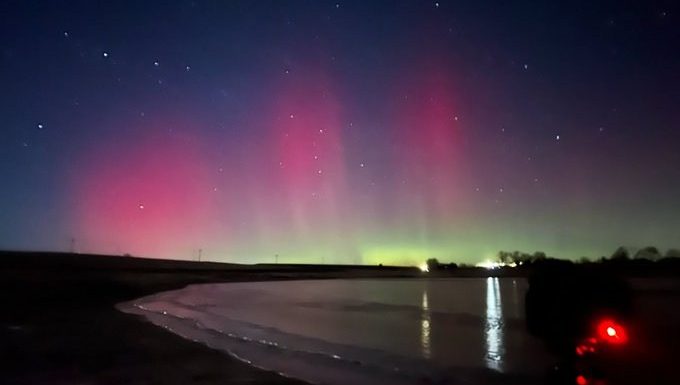
Knowing a pair of solar storms over the weekend created a good chance of seeing the northern lights on Sunday night, Michael Charnick positioned himself 15 miles north of Fort Collins in hopes of a great show. He was rewarded with what he calls the best northern lights show in northern Colorado since 2021.
It’s possible there will be a repeat show Monday night, visible near the northern horizon for viewers who get away from city lights.
“It has to be a strong event for it to be visible this far south,” said Charnick, a freelance photographer from Fort Collins who also works for the National Weather Service. “The best time to look is around what you could call solar midnight, 11 p.m. to midnight, then sometimes as late as 1 a.m. You definitely need to be far away from city lights. Even on the north end of Fort Collins, you wouldn’t have been able to see that with your naked eye.”
Charnick said it’s easier to see the lights, also called the aurora borealis, with a camera. Charnick took a stunning photo with a green glow on the horizon and red shafts of light above using an iPhone set on 10-second exposure.
“Naked eye, I was able to see it for maybe half an hour as a milky, greenish-whitish glow on the horizon,” Charnick said. “Those red pillars, you could see kind of faintly above that milky green glow with your eye as well. Red is a very difficult color to pick up at night with the naked eye. It slowly dawns on you what you’re looking at. A camera is going to pick up the reds much better than what your eye would.”
This aurora borealis was caused by coronal mass ejections from the surface of the sun that occurred Saturday and Sunday. They were detected by instruments monitored by the Space Weather Prediction Center, an office within the National Weather Service in Boulder, which issued a geomagnetic storm alert. CMEs are ejections of electrical particles with magnetic fields which interact with the earth’s magnetic field when they arrive.
“Energized particles from the sun slam into earth’s upper atmosphere at speeds of up to 45 million mph, but our planet’s magnetic field protects us from the onslaught,” according to a post on Space.com, a scientific website devoted to explaining astronomical events in language for lay persons. “As earth’s magnetic field redirects the particles toward the poles — there are southern lights, too — the dramatic process transforms into a cinematic atmospheric phenomenon that dazzles and fascinates scientists and skywatchers alike.”
The Space Weather Prediction Center watches for electromagnetic storms because CMEs have the ability to disrupt power grids, aviation communications and other services on earth. The ejections over the weekend were rated 3s on a strength scale from 1-5.
Subscribe to our weekly newsletter, The Adventurist, to get outdoors news sent straight to your inbox.
Source: Read Full Article










